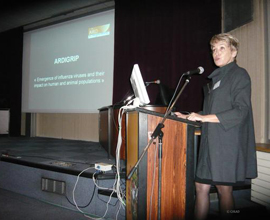Pandemics have killed millions of people, and they will strike again. They can arise anywhere, at any time. The main challenges health officials face are to quickly identify the source, how it will spread, and most importantly, how to limit a global disaster. To tackle the logistical, financial and legal barriers of mounting an effective response, a newly launched global initiative aims to coordinate and trigger appropriate actions within 48 hours of a new outbreak.
One nerve center of this effort is in Paris, where epidemiologist Bernadette Murgue serves as deputy director of France's Institute of Microbiology and Infectious Disease. After the H1N1 influenza outbreak in 2009, Murgue coordinated 60 research projects to address the threat. But a shortage of scientists, lack of funding, communication gaps and obstacles to international collaborations bogged down the response. By the time everyone had mobilized across borders, the pandemic was almost over.
Murgue’s mission is to wrangle and guide many teams sprinkled through the diverse research institutes in France to act quickly in the face of a new threat, while keeping tabs and forging new connections with global projects as well. After a session on the new initiative at the February 2014 meeting of the American Association for the Advancement of Science in Chicago, Murgue told SciCom’s Julia Calderone that it will take time to set the stage for a swift response.
How did you get into studying infectious disease?
Initially, I worked as a physician in hematology at a hospital in the South of France for about seven years. I was taking care of patients, but not doing so much research. So I moved to Boston and spent two years at Massachusetts General Hospital as a research fellow studying growth factors in cancer.
When it was time to go back to France, my husband was offered a job in Tahiti, so I found a small research institute there [the Institut Territorial de Recherches Médicales Louis Malardé] that was working on dengue fever. I didn’t know anything about dengue, but I read about it and I thought it was a fascinating infection. I worked there for almost seven years.
What kind of research were you doing?
We were looking at risk factors and the pathogenesis of dengue. We tried to understand why some people had severe infections and others didn’t. We had to battle with WHO [the World Health Organization] at the time because they didn’t agree with what we were saying about primary dengue.
What didn’t they agree with?
When I first started, there was a hypothesis from the 1950s stating that if you get a secondary infection of dengue, it will be more severe than the first. We conducted a clinical survey with more than 300 cases. We went through old files and talked to the physicians who took care of these people. We found that a high percentage of the people with severe infections actually had primary infections, which was not how it was described in these papers. We did a very careful job, but we had a lot of difficulties publishing it.
Why was it hard to publish?
An American journal said that it was a very nice study and well documented, but it couldn’t be true. So I took it to another European review. After I published it there, things slowly changed as other teams worked on it.
Another dogma was that you either get a benign form of dengue called dengue fever, or a more severe form called hemorrhagic fever, but nothing in between. In the same study, we described people who had symptoms with varying severity. We published in North America in the end, and things have changed dramatically, even at WHO. I don’t want to say that I am a pioneer, but in a way, I am.
You’re now primarily an administrator. How is the French research system organized?
I used to say that we have the same number of research institutes as we have [varieties of] cheese. There was an evaluation of the French research system around 2008. The committee was chaired by Elias Zerhouni, the former director of NIH [the U.S. National Institutes of Health]. He recommended that we have a kind of national institute like the NIH, with different research institutes organized within. Now we have the French National Alliance for Life Sciences and Health (AVIESAN). Within this alliance there are 10 institutes. My institute focuses on microbiology and infectious disease.
What is your objective?
To create a new way for all of the different research institutes in France to work together, and to coordinate and assign research priorities to these different research organizations. We also want to develop a partnership with low-income and middle-income countries.
When we first started, we had to convince people that a new organization was a good thing. I don’t want to say that it was fortunate, but the arrival of H1N1 allowed us to prove that we could do something.
"There will probably be another big epidemic or pandemic of influenza. We don’t know when it will happen."
What did you do?
The Ministry of Health commissioned us to organize a research response. We had to find money from the public and private sectors, and we were able to launch 30 research projects. It was very difficult, but also exciting.
What was the outcome of those projects?
Quite good. We have more than 60 papers published so far.
Why is it so hard to predict the next pandemic?
The influenza virus is complex. It can live in birds, mammals, and humans. It’s very plastic and can mutate or rearrange. And these viruses travel very fast. That’s the virus that can really create a big problem in the world, or maybe an equivalent of SARS [Severe Acute Respiratory Syndrome]. There is one in the Middle East at the moment [MERS-CoV (Middle East Respiratory Syndrome Coronavirus)], but it’s still only in that area. It probably requires certain conditions to be transmitted regularly, but we don’t know yet.
What conditions must be met for something to become a pandemic?
Influenza and SARS are good examples because they are transmitted through respiratory contact. That’s easy. But with something like West Nile, which is transmitted by mosquitoes, it can’t be transmitted from person to person. So you have this barrier, and it’s more difficult to have a pandemic. But let’s say someone with influenza coughs badly in a room full of people. Maybe ten people will be sick within the next few days. It’s quite easy. A mosquito can only bite one person at a time. That’s why respiratory infections are probably the most obvious pathogens to be transmitted quickly.
Why do you enjoy studying emerging diseases?
I think emerging infectious diseases are fascinating. I don’t want to say that they are a game, but you have many actors. You have the pathogen, and sometimes a vector or a reservoir, and the environment. The transmission is complex. I find it intellectually exciting.
Why did it take so long to respond to the H1N1 influenza pandemic in 2009?
The research community on influenza was small because we had a vaccine. Only a few teams were involved with it, so we had to convince clinicians or epidemiologists to work on it. But at the same time they needed to have protocols ready. We wasted time implementing all of these research projects. It took at least five months to get everything set up. By the time it was done, the epidemic was almost over.
What is the biggest challenge in preparing for an epidemic?
Human resources, money, organization, coordination, and to have the agreement of everybody that it’s important. You have to be supported by your ministries.
Is that goal attainable?
In France, yes. We already have their support. Globally, that’s what we’re trying to do with this European Initiative called GLoPID-R [the Global Research Collaboration for Infectious Disease Preparedness]. It will be very important, but of course it’s a national initiative and you have many actors. What is the best way to link them? GLoPID-R may be an answer, but we have to work on it.
There was an outbreak of Chikungunya in the Caribbean in December 2013—a mosquito-driven virus that causes fatigue, joint pain, fever, headache, and rash. How long did it take for you to respond?
We got the first report on the 5th of December. We quickly contacted different people in the French Caribbean and specialists in France. Since it was before Christmas, it was quite difficult to organize a meeting, but we were able to have a meeting on the 20th of December. Now it’s the 15th of February and we already have six projects that have been written, reviewed and will be funded quite soon. We can do better, but it’s not so bad.
What were those projects for?
To first understand what the population thinks. Are they afraid? What do they think authorities are doing? Then to have some knowledge of entomology. Some mosquitoes can be resistant to insecticide. Will the infection spread quickly? Is it possible to have epidemic in Europe? You won’t have a result in two weeks, but it’s important to do that quickly.
How are people treated in the meantime?
There are only treatments for symptoms. But there are populations that are more at risk, like pregnant women, so for them we must avoid the risk of transmission to the baby. There are many things we don’t know about Chikungunya.
What scares you the most in terms of potential future outbreaks?
There will probably be another big epidemic or pandemic of influenza. It’s not difficult to say that, but we don’t know when it will happen. Chikungunya could be quite difficult for the Americas because while the mortality is low, it’s a painful disease and can last a long time. Another threat is resistant bacteria. Would it be a pandemic facing every country at the same time? I don’t know, but it could affect a lot of different countries. SARS only affected about 20 to 25 countries. Or maybe something completely new will pop up.
The title of your session was 48 Hours To Save the World: Challenge of the Next Pandemic. Is that realistic?
48 hours to save the world doesn’t mean you’ll find a treatment or vaccine or a way to control the disease. In 48 hours you must have the diagnostic, know the pathogen, and organize the different people that are involved to work together. It’s to start quickly, because usually you start too late.
Do you think it’s possible to start that quickly?
Of course, it will take a bit of time. It won’t be tomorrow or even the end of the year, but you have to build that if you believe in it.
____________________
© 2014 Julia Calderone
Enter Julia's world of writing here: juliacalderone.com


